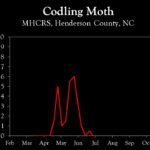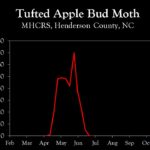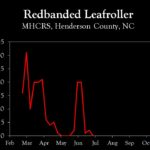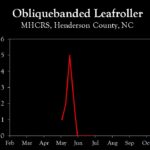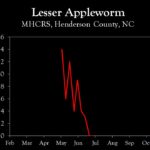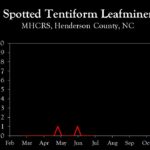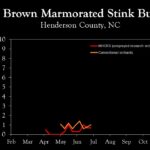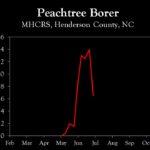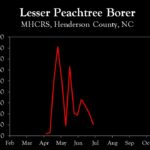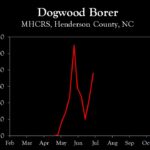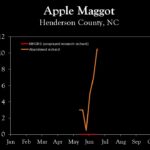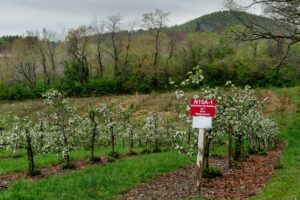WNC Orchard Insect Populations
go.ncsu.edu/readext?1064513
en Español / em Português
El inglés es el idioma de control de esta página. En la medida en que haya algún conflicto entre la traducción al inglés y la traducción, el inglés prevalece.
Al hacer clic en el enlace de traducción se activa un servicio de traducción gratuito para convertir la página al español. Al igual que con cualquier traducción por Internet, la conversión no es sensible al contexto y puede que no traduzca el texto en su significado original. NC State Extension no garantiza la exactitud del texto traducido. Por favor, tenga en cuenta que algunas aplicaciones y/o servicios pueden no funcionar como se espera cuando se traducen.
Português
Inglês é o idioma de controle desta página. Na medida que haja algum conflito entre o texto original em Inglês e a tradução, o Inglês prevalece.
Ao clicar no link de tradução, um serviço gratuito de tradução será ativado para converter a página para o Português. Como em qualquer tradução pela internet, a conversão não é sensivel ao contexto e pode não ocorrer a tradução para o significado orginal. O serviço de Extensão da Carolina do Norte (NC State Extension) não garante a exatidão do texto traduzido. Por favor, observe que algumas funções ou serviços podem não funcionar como esperado após a tradução.
English
English is the controlling language of this page. To the extent there is any conflict between the English text and the translation, English controls.
Clicking on the translation link activates a free translation service to convert the page to Spanish. As with any Internet translation, the conversion is not context-sensitive and may not translate the text to its original meaning. NC State Extension does not guarantee the accuracy of the translated text. Please note that some applications and/or services may not function as expected when translated.
Collapse ▲June 30, 2025
 Codling Moth: In lower elevation orchards (i.e., those ranging from about 800 to 1300 ft) an insecticide targeting second generation codling moth should have been applied by this time. Optimum timing is between 1400 and 1450 DD, and in Cleveland County about 1550 DD have accumulated as of June 30. If an application has not been applied in the past 7 to 10 days, an application should be considered, especially in those orchards not using mating disruption.
Codling Moth: In lower elevation orchards (i.e., those ranging from about 800 to 1300 ft) an insecticide targeting second generation codling moth should have been applied by this time. Optimum timing is between 1400 and 1450 DD, and in Cleveland County about 1550 DD have accumulated as of June 30. If an application has not been applied in the past 7 to 10 days, an application should be considered, especially in those orchards not using mating disruption.
In Henderson County (elevation about 2050 ft), a total of 1228 DD have accumulated as of June 30. We are expected to hit 1400 in about a week, so this weekend or early next week would be a good time for this application.
In orchards that have no damage and where moth captures in pheromone traps remain low, an insecticide targeting the second generation may not be necessary. This is most often the case in orchards using mating disruption.
Brown Marmorated Stink Bug (BMSB): In lower elevation orchards, emergence of first generation BMSB adults, the most damaging life stage, is expected to begin in about 10 days. Emergence begins at about 740 DD, and in Cleveland County 612 DD accumulations as of June 30. An initial insecticide spray is recommended between about 5 and 10% emergence (=760 – 780 DD), which is expected in this area in about two weeks.
In Henderson County, DD accumulations as of June 30 were only at 460, so we are at least a month away from initial emergence.
European Red Mite: Despite the warm weather, European red mite populations remain low throughout the region. As mentioned last week, predatory mite numbers have been high in almost all orchards we’ve sampled in recent weeks. Historically, if ERM do not appear by the first week of July, in many cases they are unlikely to build to damaging levels.
2025 Average Weekly Trap Captures
| HENDERSON COUNTY | |||
| Insects per trap | |||
| Jun 16 | Jun 23 | Jun 30 | |
| Codling moth | 0.0 | 0.5 | 0.0 |
| Oriental fruit moth | 12.5 | 19.0 | 16.0 |
| Tufted apple bud moth | 5.0 | 0.0 | 0.0 |
| Redbanded leafroller | 1.0 | 2.0 | 0.0 |
| Obliquebanded leafroller | 0.0 | 0.0 | 0.0 |
| Lesser appleworm | 3.0 | 0.0 | 0.0 |
| Apple maggot (unsprayed research orchards) | 0.0 | 0.0 | 0.0 |
| Apple maggot (abandoned orchard) | 5.0 | n/a | 10.5 |
| Brown marmorated stink bug (commercial orchards) | 0.6 | n/a | 1.0 |
| Brown marmorated stink bug (unsprayed research orchards) | 1.0 | 0.7 | 0.7 |
| Spotted tentiform leafminer | 0.0 | 0.0 | 0.0 |
| Dogwood borer | 20.0 | 46.0 | 76.0 |
| Peachtree borer | 12.5 | 14.0 | 6.5 |
| Lesser peachtree borer | 27.5 | 20.0 | 10.5 |
| San Jose scale | 1.3 | 0.7 | 2.5 |
*Note that these averages illustrate only the timing of insect emergence and fluctuations in populations, and are not representative of population levels in any given orchard. The only way to have an accurate assessment of an individual orchard’s populations is to set up traps in that orchard.
2025 Accumulated Degree Days
| HENDERSON COUNTY | ||||
| Jun 16 | Jun 23 | Jun 30 | ||
| Codling moth (Biofix: April 21) | 870 | 1064 | 1222 | |
| Oriental fruit moth (Biofix: March 17) | 1537 | 1770 | 1943 | |
| Tufted apple bud moth (Biofix: April 14) | 1215 | 1448 | 1621 | |
PREVIOUS REPORTS
June 24, 2025
 In Henderson County and similar elevations, first generation codling moth flight is complete, and second generation flight is not expected to occur for at least another 10 to 14 days. We remain in that period where threshold-based insecticide sprays for secondary pests (e.g., aphids, leafhoppers and mites) are the main reason for considering an application. The hot weather predicted for this week could lead to a quick build up of European red mites. However, predatory mites have been abundant in most orchards visited during the past week, and ERM were detected primarily in rows adjacent to gravel or dirt roads. Hence, be sure to scout throughout an orchard before making a decision to apply a miticide.
In Henderson County and similar elevations, first generation codling moth flight is complete, and second generation flight is not expected to occur for at least another 10 to 14 days. We remain in that period where threshold-based insecticide sprays for secondary pests (e.g., aphids, leafhoppers and mites) are the main reason for considering an application. The hot weather predicted for this week could lead to a quick build up of European red mites. However, predatory mites have been abundant in most orchards visited during the past week, and ERM were detected primarily in rows adjacent to gravel or dirt roads. Hence, be sure to scout throughout an orchard before making a decision to apply a miticide.
In lower elevation orchards such as those in Cleveland County, this week is the optimum timing for an insecticide targeting second generation codling moth. Approximately 1375 codling moth degree days have accumulated since biofix, and between about 1400 and 1450 DD coincides with early stages of second generation egg hatch. If populations are low and there is little evidence of damage to date, a single application should be sufficient for this generation. If using mating disruption, or if pheromone trap captures remain very low in non-disrupted orchards, it is likely that an insecticide may not be necessary. However, that decision should not be made without trap data to verify low numbers.
2025 Average Weekly Trap Captures
| HENDERSON COUNTY | |||
| Insects per trap | |||
| Jun 9 | Jun 16 | Jun 23 | |
| Codling moth | 1.0 | 0.0 | 0.5 |
| Oriental fruit moth | 16.5 | 12.5 | 19.0 |
| Tufted apple bud moth | 23.0 | 5.0 | 0.0 |
| Redbanded leafroller | 20.0 | 1.0 | 2.0 |
| Obliquebanded leafroller | 0.0 | 0.0 | 0.0 |
| Lesser appleworm | 4.0 | 3.0 | 0.0 |
| Apple maggot (unsprayed research orchards) | 0.0 | 0.0 | 0.0 |
| Apple maggot (abandoned orchard) | 0.5 | 5.0 | n/a |
| Brown marmorated stink bug (commercial orchards) | 1.4 | 0.6 | n/a |
| Brown marmorated stink bug (unsprayed research orchards) | 0.3 | 1.0 | 0.7 |
| Spotted tentiform leafminer | 0.0 | 0.0 | 0.0 |
| Dogwood borer | 48.0 | 20.0 | 46.0 |
| Peachtree borer | 13.0 | 12.5 | 14.0 |
| Lesser peachtree borer | 33.0 | 27.5 | 20.0 |
| San Jose scale | 0.0 | 1.3 | 0.7 |
*Note that these averages illustrate only the timing of insect emergence and fluctuations in populations, and are not representative of population levels in any given orchard. The only way to have an accurate assessment of an individual orchard’s populations is to set up traps in that orchard.
2025 Accumulated Degree Days
| HENDERSON COUNTY | ||||
| Jun 9 | Jun 16 | Jun 23 | ||
| Codling moth (Biofix: April 21) | 719 | 870 | 1044 | |
| Oriental fruit moth (Biofix: March 17) | 1351 | 1537 | n/a | |
| Tufted apple bud moth (Biofix: April 14) | 1029 | 1215 | n/a | |
June 17, 2025
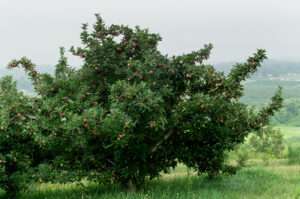 Codling Moth: Throughout the region we remain in that window where codling moth is between generations, and unless there is a history of problems (current or past years), there is a low probability that insecticides are necessary. In most orchards that have low populations, a single insecticide application against the second generation at about 1450 Degree Days serves as a good preventive application for this generation; Cleveland County is currently at about 1200 DD and Henderson County is at about 900 DD. Based on weather forecasts, 1450 DD is predicted for the Cleveland County area early next week. In Henderson County, 1450 is not expected for at least another two weeks.
Codling Moth: Throughout the region we remain in that window where codling moth is between generations, and unless there is a history of problems (current or past years), there is a low probability that insecticides are necessary. In most orchards that have low populations, a single insecticide application against the second generation at about 1450 Degree Days serves as a good preventive application for this generation; Cleveland County is currently at about 1200 DD and Henderson County is at about 900 DD. Based on weather forecasts, 1450 DD is predicted for the Cleveland County area early next week. In Henderson County, 1450 is not expected for at least another two weeks.
While we are in the mid-flight period of second generation OFM in Henderson County and similar elevations, populations have been low in most areas.
Indirect Pests: European red mite (ERM) and potato leafhopper are the key indirect pests that should be scouted for at this time. The potential for ERM populations to increase to threshold levels will increase with rising temperatures over the next couple of weeks. A threshold of about 5 mites per leaf (equivalent to about 80% of leaves infested with 1 or more mites) is a good level to assess whether or not a miticide is necessary. If predatory mites are not present and ERM continue to increase, a miticide should be applied. Products with quick knockdown activity are required in these situations, and include Acramite (bifenazate), Kanemite (acequinocyl), Envidor (spirodiclofen), Portal (fenpyroximate), and Nealta (cyflumetofen).
Potato leafhoppers feed on new shoot growth, resulting in hopper burn on leaves (curling and yellowing of leaves on the edges). Control is most important on young trees where shoot growth is encouraged. On larger or older trees where shoot growth is discouraged, damage is less impactful, although from a cosmetic perspective many growers prefer to treat before damage is too extensive. Low rates of all insecticides in MOA Group 4 (neonics) and other insecticides recommended for aphids (e.g., Versys, Beleaf, and Movento) all provide excellent control.
Learn more about southeastern apple insect pests at the Apple Insect Management page.
2025 Average Weekly Trap Captures
| HENDERSON COUNTY | |||
| Insects per trap | |||
| Jun 2 | Jun 9 | Jun 16 | |
| Codling moth | 3.5 | 1.0 | 0.0 |
| Oriental fruit moth | 15.0 | 16.5 | 12.5 |
| Tufted apple bud moth | 38.0 | 23.0 | 5.0 |
| Redbanded leafroller | 20.0 | 20.0 | 1.0 |
| Obliquebanded leafroller | 0.0 | 0.0 | 0.0 |
| Lesser appleworm | 9.0 | 4.0 | 3.0 |
| Apple maggot (unsprayed research orchards) | 0.0 | 0.0 | 0.0 |
| Apple maggot (abandoned orchard) | 3.0 | 0.5 | 5.0 |
| Brown marmorated stink bug (commercial orchards) | 1.0 | 1.4 | 0.6 |
| Brown marmorated stink bug (unsprayed research orchards) | 0.3 | 0.3 | 1.0 |
| Spotted tentiform leafminer | 1.0 | 0.0 | 0.0 |
| Dogwood borer | 58.0 | 48.0 | 20.0 |
| Peachtree borer | 8.0 | 13.0 | 12.5 |
| Lesser peachtree borer | 19.0 | 33.0 | 27.5 |
| San Jose scale | 0.0 | 0.0 | 1.3 |
*Note that these averages illustrate only the timing of insect emergence and fluctuations in populations, and are not representative of population levels in any given orchard. The only way to have an accurate assessment of an individual orchard’s populations is to set up traps in that orchard.
2025 Accumulated Degree Days
| HENDERSON COUNTY | ||||
| Jun 2 | Jun 9 | Jun 16 | ||
| Codling moth (Biofix: April 21) | 578 | 719 | 870 | |
| Oriental fruit moth (Biofix: March 17) | 1175 | 1351 | 1537 | |
| Tufted apple bud moth (Biofix: April 14) | 853 | 1029 | 1215 | |
June 9, 2025
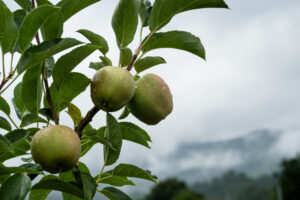 Depending on elevation, we are either approaching or in that period when most major pests exhibit a low potential for damage, and when insecticide sprays can often be skipped. Codling moth degree-day (DD) accumulations range from about 720 in Henderson County to 1002 in Shelby. First generation codling moth is generally of little concern following a second period of activity between about 600 and 650 DD, which occurred last week in Henderson County. If not using pheromone traps to monitor for codling moth, and if an insecticide has not been used in the past 14 days, a final application should be considered this week. But in most situations both codling moth and oriental fruit moth populations have been very low this year.
Depending on elevation, we are either approaching or in that period when most major pests exhibit a low potential for damage, and when insecticide sprays can often be skipped. Codling moth degree-day (DD) accumulations range from about 720 in Henderson County to 1002 in Shelby. First generation codling moth is generally of little concern following a second period of activity between about 600 and 650 DD, which occurred last week in Henderson County. If not using pheromone traps to monitor for codling moth, and if an insecticide has not been used in the past 14 days, a final application should be considered this week. But in most situations both codling moth and oriental fruit moth populations have been very low this year.
With key pests of relatively low importance at this time, insecticide applications should be based on an as-needed basis for potato leafhoppers, apple aphids and European red mite. A survey of about 10 orchards last week found very low numbers of all these pests. However, mite populations can increase quickly, so monitoring at least weekly is important. Now is also a good time to check fruit for evidence of San Jose scale infestation, which may be present where early season control was not ideal.
Learn more about southeastern apple insect pests at the Apple Insect Management page.
2025 Average Weekly Trap Captures
| HENDERSON COUNTY | |||
| Insects per trap | |||
| May 27 | Jun 2 | Jun 9 | |
| Codling moth | 6.0 | 3.5 | 1.0 |
| Oriental fruit moth | 7.0 | 15.0 | 16.5 |
| Tufted apple bud moth | 70.0 | 38.0 | 23.0 |
| Redbanded leafroller | 2.0 | 20.0 | 20.0 |
| Obliquebanded leafroller | 2.0 | 0.0 | 0.0 |
| Lesser appleworm | 4.0 | 9.0 | 4.0 |
| Apple maggot (unsprayed research orchards) | 0.0 | 0.0 | 0.0 |
| Apple maggot (abandoned orchard) | 3.0 | 3.0 | 0.5 |
| Brown marmorated stink bug (commercial orchards) | 0.6 | 1.0 | 1.4 |
| Brown marmorated stink bug (unsprayed research orchards) | 0.3 | 0.3 | 0.3 |
| Spotted tentiform leafminer | 0.0 | 1.0 | 0.0 |
| Dogwood borer | 110.0 | 58.0 | 48.0 |
| Peachtree borer | 1.5 | 8.0 | 13.0 |
| Lesser peachtree borer | 20.5 | 19.0 | 33.0 |
| San Jose scale | 0.0 | 0.0 | 0.0 |
*Note that these averages illustrate only the timing of insect emergence and fluctuations in populations, and are not representative of population levels in any given orchard. The only way to have an accurate assessment of an individual orchard’s populations is to set up traps in that orchard.
2025 Accumulated Degree Days
| HENDERSON COUNTY | ||||
| May 27 | Jun 2 | Jun 9 | ||
| Codling moth (Biofix: April 21) | 502 | 578 | 719 | |
| Oriental fruit moth (Biofix: March 17) | 1069 | 1175 | 1351 | |
| Tufted apple bud moth (Biofix: April 14) | 747 | 853 | 1029 | |
June 2, 2025
 In orchards at elevations of about 2000 ft or higher (e.g., Henderson County), this week should see the last major codling moth activity of the first generation. At lower elevations (Cleveland Co.) the first generation is essentially complete and now is a time when insecticide use can typically be held back.
In orchards at elevations of about 2000 ft or higher (e.g., Henderson County), this week should see the last major codling moth activity of the first generation. At lower elevations (Cleveland Co.) the first generation is essentially complete and now is a time when insecticide use can typically be held back.
Codling Moth: As of today (6/2), approximately 580 DD have accumulated since biofix in Henderson County. A second flush of moth activity often occurs between now and 650 DD, which will occur later this week. If not monitoring flight with pheromone traps, it should be assumed that a potentially damaging population exists.
Almost 900 DD have accumulated in Cleveland County and similar locations, and first generation flight is nearly complete. Unless pheromone trap captures are high or there is already evidence of damage, it is unlikely that further management actions will be necessary until second generation flight at about 1400 DD.
TABM: Tufted apple bud moth degree-day accumulations are at 850 DD in Henderson County, which is ideal timing for an insecticide application for season-long control of this pest. Since insecticides effective against codling moth also provide excellent TABM control, both can be controlled with the recommended products (below). There is about a 3-week window for controlling TABM, which in Henderson County ranges from last week through next week.
In those orchards using mating disruption for codling moth, and where to date supplemental control for codling moth has not been necessary, an insecticide for TABM should be made at this time. If codling moth is not a concern, Intrepid at 8 oz per acre is an option that will provide excellent control of TABM. However, if concerned about codling moth, a diamide (Altacor, Exirel or Verdepryn) or spinosyn (Delegate), depending on your rotational program, should be used.
Other Pests: As mentioned last week, June is the time when populations of common secondary pests – European red mite, aphids and leafhoppers – begin to increase, so monitoring for these pests should be underway.
Learn more about southeastern apple insect pests at the Apple Insect Management page.
2025 Average Weekly Trap Captures
| HENDERSON COUNTY | |||
| Insects per trap | |||
| May 19 | May 27 | June 2 | |
| Codling moth | 5.5 | 6.0 | 3.5 |
| Oriental fruit moth | 13.5 | 7.0 | 15.0 |
| Tufted apple bud moth | 42.0 | 70.0 | 38.0 |
| Redbanded leafroller | 0.0 | 2.0 | 20.0 |
| Obliquebanded leafroller | 5.0 | 2.0 | 0.0 |
| Lesser appleworm | 12.0 | 4.0 | 9.0 |
| Apple maggot (unsprayed research orchards) | set | 0.0 | 0.0 |
| Apple maggot (abandoned orchard) | set | 3.0 | 3.0 |
| Brown marmorated stink bug (commercial orchards) | 1.2 | 0.6 | 1.0 |
| Brown marmorated stink bug (unsprayed research orchards) | 1.0 | 0.3 | 0.3 |
| Spotted tentiform leafminer | 0.0 | 0.0 | 1.0 |
| Dogwood borer | 48.0 | 110.0 | 58.0 |
| Peachtree borer | 2.0 | 1.5 | 8.0 |
| Lesser peachtree borer | 63.0 | 20.5 | 19.0 |
| San Jose scale | 1.7 | 0.0 | 0.0 |
*Note that these averages illustrate only the timing of insect emergence and fluctuations in populations, and are not representative of population levels in any given orchard. The only way to have an accurate assessment of an individual orchard’s populations is to set up traps in that orchard.
2025 Accumulated Degree Days
| HENDERSON COUNTY | ||||
| May 19 | May 27 | Jun 2 | ||
| Codling moth (Biofix: April 21) | 391 | 502 | 578 | |
| Oriental fruit moth (Biofix: March 17) | 920 | 1069 | 1175 | |
| Tufted apple bud moth (Biofix: April 14) | 598 | 747 | 853 | |
May 27, 2025
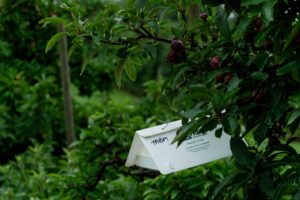 First generation codling moth remains a key pest of concern across the region. Also, the window for tufted apple bud moth control is open in all areas. A smattering of problems with stink bugs has been reported, and we will soon be approaching the time to begin monitoring for key indirect pests.
First generation codling moth remains a key pest of concern across the region. Also, the window for tufted apple bud moth control is open in all areas. A smattering of problems with stink bugs has been reported, and we will soon be approaching the time to begin monitoring for key indirect pests.
Codling moth: The degree-day model indicates that we are in the middle of first generation flight in Henderson County and approaching the end of flight in lower-elevation Cleveland County. If not monitoring for moths using traps and/or mating disruption, it should be assumed that insecticidal control is necessary in Henderson County at this time. In lower-elevation orchards, if an insecticide effective against codling moth has been applied in the past week, in most orchards that should be sufficient for the remainder of this generation. The exception is in those orchards with historically high codling moth populations.
Tufted apple bud moth: The ideal timing for an insecticide application to achieve season-long control of TABM is between about 800 and 1200 DD. TABM DD ranges from about 750 in Henderson County to 955 in Cleveland County, so this next application will provide ideal timing. Insecticides recommended for codling moth are also excellent against TABM (Altacor, Exirel, Verdepryn, Delegate). In areas where codling moth control is not needed, Intrepid at rates as low as 8 oz/acre will provide excellent TABM control.
Other Pests: In at least one orchard at a lower elevation, significant early season damage by brown marmorated stink bug was reported and confirmed. This was feeding by overwintering adults, which typically are not present in numbers high enough to inflict noticeable damage this early. This orchard is apparently in a BMSB hotspot.
Now is also a good time to begin monitoring for common indirect pests, including European red mite, potato leafhopper and green apple aphids.
Learn more about southeastern apple insect pests at the Apple Insect Management page.
2025 Average Weekly Trap Captures
| HENDERSON COUNTY | |||
| Insects per trap | |||
| May 12 | May 19 | May 27 | |
| Codling moth | 1.5 | 5.5 | 6.0 |
| Oriental fruit moth | 10.5 | 13.5 | 7.0 |
| Tufted apple bud moth | 48.0 | 42.0 | 70.0 |
| Redbanded leafroller | 0.0 | 0.0 | 2.0 |
| Obliquebanded leafroller | 2.0 | 5.0 | 2.0 |
| Lesser appleworm | 6.0 | 12.0 | 4.0 |
| Apple maggot (research orchards) | n/a | set | 0.0 |
| Apple maggot (abandoned orchard) | n/a | n/a | 3.0 |
| Brown marmorated stink bug (commercial) | 0.6 | n/a | 0.6 |
| Brown marmorated stink bug (unsprayed research orchard) | 0.3 | 1.0 | 0.3 |
| Spotted tentiform leafminer | 0.0 | 0.0 | 0.0 |
| Dogwood borer | 29.0 | 48.0 | 110.0 |
| Peachtree borer | 0.5 | 2.0 | 1.5 |
| Lesser peachtree borer | 9.0 | 63.0 | 20.5 |
| San Jose scale | 0.0 | 1.7 | 0.0 |
*Note that these averages illustrate only the timing of insect emergence and fluctuations in populations, and are not representative of population levels in any given orchard. The only way to have an accurate assessment of an individual orchard’s populations is to set up traps in that orchard.
2025 Accumulated Degree Days
| HENDERSON COUNTY | ||||
| May 12 | May 19 | May 27 | ||
| Codling moth (Biofix: April 21) | 263 | 391 | 502 | |
| Oriental fruit moth (Biofix: March 17) | 757 | 920 | 1069 | |
| Tufted apple bud moth (Biofix: April 14) | 435 | 598 | 747 | |
May 19, 2025
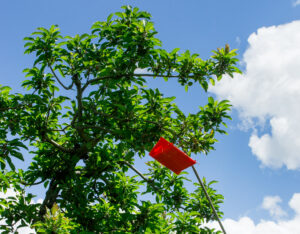 Codling moth degree-day accumulations range from about 370 in Henderson County (2100 ft) to about 600 in the lower elevation of Cleveland County (about 900 ft). This represents peak activity throughout the region, so if not using pheromone traps to monitor populations, one should assume a damaging population exists and a codling moth recommended insecticide should be applied if one has not been made in the past 10 to 14 days. (See the table of codling moth insecticide efficacy.)
Codling moth degree-day accumulations range from about 370 in Henderson County (2100 ft) to about 600 in the lower elevation of Cleveland County (about 900 ft). This represents peak activity throughout the region, so if not using pheromone traps to monitor populations, one should assume a damaging population exists and a codling moth recommended insecticide should be applied if one has not been made in the past 10 to 14 days. (See the table of codling moth insecticide efficacy.)
Tufted apple bud moth (TABM) degree-day accumulations are currently about 775 DD in Cleveland County. A single application of either Altacor, Exirel, Verdepryn, Delegate, or Intrepid applied between about 700 to 1200 DD will provide excellent season-long control of TABM. Degree-days in Henderson County are only at about 656, so waiting until the next or following week to apply an insecticide targeting this pest would be ideal.
TABM is a leafroller that was once a major pest in many production areas in the southeast, but since registration of Intrepid in the early 2000s, along with Altacor and Delegate in 2008, it has become a minor pest. However, it continues to be captured in pheromone traps, and when insecticides are not applied, damage has been observed later in the season.
Learn more about southeastern apple insect pests at the Apple Insect Management page.
2025 Average Weekly Trap Captures
| HENDERSON COUNTY | |||
| Insects per trap | |||
| May 5 | May 12 | May 19 | |
| Codling moth | 1.0 | 1.5 | 5.5 |
| Oriental fruit moth | 12.0 | 12.0 | 13.5 |
| Tufted apple bud moth | 49.0 | 49.0 | 42.0 |
| Redbanded leafroller | 0.0 | 0.0 | 0.0 |
| Obliquebanded leafroller | 1.0 | 1.0 | 5.0 |
| Lesser appleworm | 14.0 | 14.0 | 12.0 |
| Apple maggot (research orchards) | n/a | n/a | set |
| Apple maggot (abandoned orchard) | n/a | n/a | n/a |
| Brown marmorated stink bug (commercial) | 1.1 | 0.6 | n/a |
| Brown marmorated stink bug (unsprayed research orchard) | 0.0 | 0.3 | 1.0 |
| Spotted tentiform leafminer | 0.0 | 0.0 | 0.0 |
| Dogwood borer | 18.0 | 29.0 | 48.0 |
| Peachtree borer | 0.0 | 0.5 | 2.0 |
| Lesser peachtree borer | 49.5 | 9.0 | 63.0 |
| San Jose scale | 0.0 | 0.0 | 1.7 |
*Note that these averages illustrate only the timing of insect emergence and fluctuations in populations, and are not representative of population levels in any given orchard. The only way to have an accurate assessment of an individual orchard’s populations is to set up traps in that orchard.
2025 Accumulated Degree Days
| HENDERSON COUNTY | ||||
| May 5 | May 12 | May 19 | ||
| Codling moth (Biofix: April 21) | 202 | 263 | 391 | |
| Oriental fruit moth (Biofix: March 17) | 666 | 757 | 920 | |
| Tufted apple bud moth (Biofix: April 14) | 343 | 435 | 598 | |
May 12, 2025
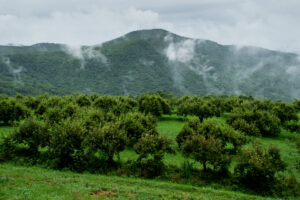 Recent hail in some orchards will surely affect decisions on continuing to invest in pesticide costs, but for those orchards where management will continue, codling moth and preventive applications of miticides for European red mite remain the primary focus this week. Refer to last week’s recommendations for European red mite management.
Recent hail in some orchards will surely affect decisions on continuing to invest in pesticide costs, but for those orchards where management will continue, codling moth and preventive applications of miticides for European red mite remain the primary focus this week. Refer to last week’s recommendations for European red mite management.
Codling Moth: As of May 12, codling moth degree-day accumulations range from about 250 in Henderson County to 475 in Cleveland County. First generation codling moth is most active from about 250 through about 700 or 800 DD, so this pest will remain a threat for the next two to four weeks, depending on location and temperature. The cool and rainy weather since late last week has not been conducive for moth mating, egg laying or survival of larvae hatching from eggs, so from an insecticide perspective it is better to wait until the current weather pattern breaks before making insecticide applications.
As summarized in last week’s codling moth update, codling moth egg hatch begins at about 250 DD, but will vary with population intensity. In orchards with low populations, delaying an initial application until 350 is recommended. However, with the time interval of 250 and 350 only about 5 days and weather not currently conducive for spraying, an application is recommended for most orchards as soon as the weather clears. The exception is in orchards using mating disruption or where pheromone trap captures remain very low.
Learn more about southeastern apple insect pests at the Apple Insect Management page.
2025 Average Weekly Trap Captures
| HENDERSON COUNTY | |||
| Insects per trap | |||
| Apr 28 | May 5 | May 12 | |
| Codling moth | 5.0 | 1.0 | 1.5 |
| Oriental fruit moth | 23.0 | 12.0 | 10.5 |
| Tufted apple bud moth | 48.0 | 49.0 | 48.0 |
| Redbanded leafroller | 1.0 | 0.0 | 0.0 |
| Obliquebanded leafroller | set | 1.0 | 2.0 |
| Lesser appleworm | set | 14.0 | 6.0 |
| Apple maggot (research orchards) | n/a | n/a | n/a |
| Apple maggot (abandoned orchard) | n/a | n/a | n/a |
| Brown marmorated stink bug (commercial) | set | 1.1 | n/a |
| Brown marmorated stink bug (unsprayed research orchard) | 0.0 | 0.0 | 0.3 |
| Spotted tentiform leafminer | 0.0 | 0.0 | 0.0 |
| Dogwood borer | 1.0 | 18.0 | 29.0 |
| Peachtree borer | set | 0.0 | 0.5 |
| Lesser peachtree borer | 81.0 | 49.5 | 9.0 |
| San Jose scale | 2.5 | 0.0 | 0.0 |
*Note that these averages illustrate only the timing of insect emergence and fluctuations in populations, and are not representative of population levels in any given orchard. The only way to have an accurate assessment of an individual orchard’s populations is to set up traps in that orchard.
2025 Accumulated Degree Days
| HENDERSON COUNTY | ||||
| Apr 28 | May 5 | May 12 | ||
| Codling moth (Biofix: April 21) | 116 | 202 | 263 | |
| Oriental fruit moth (Biofix: March 17) | 413 | 666 | 757 | |
| Tufted apple bud moth (Biofix: April 14) | 111 | 343 | 435 | |
May 5, 2025
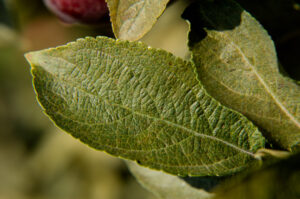 Codling Moth: The cooler weather pattern has slowed degree-day accumulations, and consequently codling moth development has fallen behind last week’s predictions. As of May 5, Henderson and Cleveland County have accumulated 190 and 340 DD, respectively. With the initial egg hatch of the first generation starting at 250 DD, orchards at lower elevations should have applied an insecticide by this time. Under moderate codling moth pressure, the diamides (Altacor, Exirel, Verdepryn or Voliam Flexi) and Delegate will provide two weeks’ residual control. Shorter interval applications may be necessary under intense codling moth pressure or where rainfall has prematurely reduced residue activity.
Codling Moth: The cooler weather pattern has slowed degree-day accumulations, and consequently codling moth development has fallen behind last week’s predictions. As of May 5, Henderson and Cleveland County have accumulated 190 and 340 DD, respectively. With the initial egg hatch of the first generation starting at 250 DD, orchards at lower elevations should have applied an insecticide by this time. Under moderate codling moth pressure, the diamides (Altacor, Exirel, Verdepryn or Voliam Flexi) and Delegate will provide two weeks’ residual control. Shorter interval applications may be necessary under intense codling moth pressure or where rainfall has prematurely reduced residue activity.
In Henderson County and similar elevations, 250 DD is now predicted to occur on Sunday, May 10. Hence, in orchards with consistent captures of codling moth in pheromone traps, the ideal timing for an initial insecticide application is this weekend or early next week. In orchards with low codling moth populations (e.g., no recent history of damage, and low and sporadic pheromone trap captures), it is recommended to delay an initial application until about 350 DD, now predicted to occur late next week. Finally, in orchards with mating disruption and low trap captures, an insecticide is usually not required until about approximately 600 DD, which coincides with optimum timing of tufted apple bud moth; this usually occurs in the first or second week of June.
European Red Mite: For those growers choosing to make a preventive miticide application, we are approaching that window of opportunity, generally considered to be between first and second cover spray. However, an alternative timing is to make the application when mites are present at 0.5 to 1 per leaf.
Studies last year confirmed that ERM populations in some orchards were exhibiting increased tolerance to Zeal, which emphasizes the importance of rotating products with different modes of action (MOA). When choosing a product to rotate with Zeal, it is important to remember that Apollo and Savey have similar modes of action to Zeal; both are in IRAC MOA Group 10 (Apollo and Savey 10A, Zeal 10B), so rotating with these products is not recommended. Two other common preventive materials are Agri-Mek (MOA 5), which should be applied at petal fall for best results, and Envidor (MOA 23). Envidor has activity against all mite life stages and also has long residual activity.
Preventive miticide use increased over the last 10 years with the appearance of the brown marmorated stink bug (BMSB) and reliance on pyrethroids to control this insect. Before that time, miticide use was much lower due to biological control. Although no systematic surveys have been conducted, predatory mite populations in commercial orchards were commonly observed last year, suggesting that they have adapted to pyrethroids. For this reason, it would be beneficial to forego preventive miticide use in some orchards to see if we have returned to the situation where biological control alone can provide effective control of ERM.
Learn more about southeastern apple insect pests at the Apple Insect Management page.
2025 Average Weekly Trap Captures
| HENDERSON COUNTY | |||
| Insects per trap | |||
| Apr 21 | Apr 28 | May 5 | |
| Codling moth | 1.5 | 5.0 | 1.0 |
| Oriental fruit moth | 54.5 | 23.0 | 12.0 |
| Tufted apple bud moth | 20.0 | 48.0 | 49.0 |
| Redbanded leafroller | 5.0 | 1.0 | 0.0 |
| Obliquebanded leafroller | n/a | set | 1.0 |
| Lesser appleworm | n/a | set | 14.0 |
| Apple maggot (research orchards) | n/a | n/a | n/a |
| Apple maggot (abandoned orchard) | n/a | n/a | n/a |
| Brown marmorated stink bug (commercial) | n/a | n/a | 1.1 |
| Brown marmorated stink bug (unsprayed research orchard) | 0.0 | 0.0 | 0.0 |
| Spotted tentiform leafminer | 0.0 | 0.0 | 0.0 |
| Dogwood borer | 0.0 | 1.0 | 18.0 |
| Peachtree borer | n/a | set | 0.0 |
| Lesser peachtree borer | 51.0 | 81.0 | 49.5 |
| San Jose scale | 0.0 | 2.5 | 0.0 |
*Note that these averages illustrate only the timing of insect emergence and fluctuations in populations, and are not representative of population levels in any given orchard. The only way to have an accurate assessment of an individual orchard’s populations is to set up traps in that orchard.
2025 Accumulated Degree Days
| HENDERSON COUNTY | ||||
| Apr 21 | Apr 28 | May 5 | ||
| Codling moth (Biofix: April 21) | Biofix | 116 | 202 | |
| Oriental fruit moth (Biofix: March 17) | 304 | 413 | 666 | |
| Tufted apple bud moth (Biofix: April 14) | Biofix | 111 | 343 | |
April 28, 2025
 With petal fall sprays completed throughout the region, the focus for the next few weeks will be on first generation codling moth. The codling moth degree-day model predicts egg hatch from 250 DD to about 1,000 DD. Currently, degree-day accumulations in lower elevation locations (e.g., Cleveland County) are predicted to reach 250 DD this Wednesday (April 30), while in Henderson County 250 is not predicted until May 7.
With petal fall sprays completed throughout the region, the focus for the next few weeks will be on first generation codling moth. The codling moth degree-day model predicts egg hatch from 250 DD to about 1,000 DD. Currently, degree-day accumulations in lower elevation locations (e.g., Cleveland County) are predicted to reach 250 DD this Wednesday (April 30), while in Henderson County 250 is not predicted until May 7.
The number of insecticide applications and choice of materials to apply will depend on: 1) whether or not mating disruption is being used, 2) the intensity of codling moth populations in individual orchards, and 3) weather conditions. The best decisions are made when pheromone traps are being used to monitor the intensity of populations, and use of the codling moth degree-day model to time applications with egg hatch of the first generation.
Mating Disruption: In orchards where mating disruption has been used for 3 or more years, codling moth populations are typically so low that insecticides are usually not needed. However, pheromone trapping is still recommended to confirm the absence of moth activity and/or detect the “unexpected.” We recommend a threshold of at least 3 cumulative moths captured over a 2-week period to dictate supplemental insecticide sprays under mating disruption (see below for lure types).
Non-Disruption Orchards: Where mating disruption is not being used for codling moth, pheromone trapping is especially important to monitor the intensity of moth populations and help determine frequency of insecticide use during the first generation. While there is not a well established relationship between moth populations and damage, a conservative threshold level of 5 moths over a one week period (using a CM L2 lure) has been successful in minimizing damage.
Pheromone Traps: The type of trap and pheromone lure used is important for codling moth monitoring programs. Either wing traps or Delta traps are recommended. Delta traps are easier to use since they have sticky cards (liners) that easily slide into and out of the trap. Plus the Delta trap provides better protection against rain. Placing traps in the upper one-third of the canopy is recommended, because moth activity is concentrated in this area. Finally, there are several types of pheromone lures available for purchase, but our recommendations have all been developed using the Trece CM L2 lure, which has a 2X rate of pheromone and should be replaced at 8-week intervals. A longer lasting lure (CM L2-P) that needs to be replaced at 12-week intervals has recently been developed and performs similarly to the CM L2.
The number of traps to deploy needs to be a compromise between detection of moths when populations are low and what is practical. One trap per 10 acres of orchard is considered the minimum, but location is probably more important. Traps should be placed at locations where moth numbers are suspected of being high, such as near packing houses, bin storage areas, or adjacent to nearby abandoned orchards.
Codling Moth Degree-Day Model: A codling moth degree-day (DD) model that predicts egg hatch of each generation was developed in the 1970s in Michigan, and has been a key tool used to time insecticide applications. The original model has been refined and updated with phenology data to different regions, including western NC. First generation egg hatch is predicted to occur from about 250 DD through 1,000 DD. However, the length of egg hatch varies considerably depending on the size of the population. Models were developed using high population densities, and only under this scenario does egg laying occur over the entire period from 250 to 1000 DD; hence, the importance of using traps to monitor the intensity of populations.
Insecticide Options: Since 2008, the apple industry has relied primarily on two groups of insecticides for codling moth control – the diamides (Altacor, Exirel, and Verdepryn) and spinosyns (Delegate). While some resistance has been detected in more northern apple areas, to date none has been suspected in the southeast. Relying on only one mode of action (diamides versus spinosyns) during a respective generation has been a good resistance management strategy. It should be noted that under low to moderate codling moth populations, initial egg hatch can occur later than 250, so using an alternative insecticide at 250 DD can help to further minimize use of the diamides and spinosyns. Among the alternatives, Assail and Imidan are the most effective alternatives. An advantage of Assail is that it also has San Jose scale activity.
Relative Efficacy of Insecticides for Codling Moth
| Mode of Action Category | Trade Name (common) | Efficacy Rating | Comments |
| Diamides | Altacor (chlorantraniliprole) | Excellent | If using a product against 1st generation, do not use against 2nd generation, or vice versa. |
| Exirel (cyantraniliprole) | Excellent | ||
| Verdepryn (cyclaniliprole) | Excellent | ||
| Spinosyns | Delegate (spinetoram) | Excellent | If using a product against 1st generation, do not use against 2nd generation, or vice versa. Can flare woolly apple aphid populations. |
| Neonicotinoids | Assail (acetamiprid) | Very Good | Also has San Jose scale activity. |
| Organophosphates | Imidan (phosmet) | Good | |
| Diacylhydrazines | Intrepid (methoxyfenozide) | Good | Should be used at 16 oz/acre for codling moth. |
| Benzoylureas | Rimon (novaluron) | Good | Can flare European red mite populations. |
| Baculoviruses | Cyd-X HP (Cydia pomonella virus) | Should be used preventively. Organically approved. |
Learn more about southeastern apple insect pests at the Apple Insect Management page.
2025 Average Weekly Trap Captures
| HENDERSON COUNTY | |||
| Insects per trap | |||
| Apr 14 | Apr 21 | Apr 28 | |
| Codling moth | 0.0 | 1.5 | 5.0 |
| Oriental fruit moth | 18.5 | 54.5 | 23.0 |
| Tufted apple bud moth | 1.0 | 20.0 | 48.0 |
| Redbanded leafroller | 4.0 | 5.0 | 1.0 |
| Obliquebanded leafroller | n/a | n/a | set |
| Lesser appleworm | n/a | n/a | set |
| Apple maggot (research orchards) | n/a | n/a | n/a |
| Apple maggot (abandoned orchard) | n/a | n/a | n/a |
| Brown marmorated stink bug (commercial) | n/a | n/a | n/a |
| Brown marmorated stink bug (unsprayed research orchard) | 0.0 | 0.0 | 0.0 |
| Spotted tentiform leafminer | 0.0 | 0.0 | 1.0 |
| Dogwood borer | n/a | 0.0 | 1.0 |
| Peachtree borer | n/a | n/a | set |
| Lesser peachtree borer | 3.0 | 51.0 | 81.0 |
| San Jose scale | 0.0 | 0.0 | 2.5 |
*Note that these averages illustrate only the timing of insect emergence and fluctuations in populations, and are not representative of population levels in any given orchard. The only way to have an accurate assessment of an individual orchard’s populations is to set up traps in that orchard.
2025 Accumulated Degree Days
| HENDERSON COUNTY | ||||
| Apr 14 | Apr 21 | Apr 28 | ||
| Codling moth (Biofix: April 21) | n/a | Biofix | 116 | |
| Oriental fruit moth (Biofix: March 17) | 304 | 413 | 546 | |
| Tufted apple bud moth (Biofix: April 14) | Biofix | 111 | 224 | |
April 21, 2025
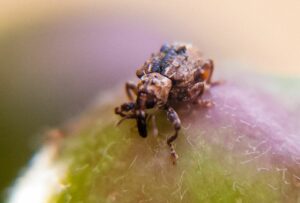 The majority of apples throughout the region are at petal fall, with some later cultivars still blooming. As discussed in last week’s update, plum curculio and oriental fruit moth are the key pests of concern (see table of insecticide options below). Also, for those that did not apply an insecticide targeting San Jose scale before bloom, a product effective against that insect should be made by First Cover.
The majority of apples throughout the region are at petal fall, with some later cultivars still blooming. As discussed in last week’s update, plum curculio and oriental fruit moth are the key pests of concern (see table of insecticide options below). Also, for those that did not apply an insecticide targeting San Jose scale before bloom, a product effective against that insect should be made by First Cover.
At the Mountain Horticultural Crops Research Station in Mills River, codling moth biofix occurred today (April 21). While we do not have traps off the mountain, biofix in Cleveland and Lincoln County is usually about 7 days before Henderson County, so for modeling purposes we have set biofix in those areas as April 14. Based on the weather forecast, It is anticipated that an initial insecticide application targeting codling moth (about 250 DD, early egg hatch) in the Cleveland/Lincoln County area will occur on April 29 or 30. In Henderson County, it will likely be another 2 weeks before codling moth egg hatch begins.
Relative Efficacy of Insecticides for Petal Fall
(─ no activity, 1 = least effective, 5 = most effective)
| Insecticide (active ingredient) | Plum curculio | Oriental fruit moth | Rosy apple aphid | San Jose scale | Toxicity to Bees |
| Actara (thiamethoxam) | 5 | 2 | 5 | ─ | Highly toxic |
| Assail (acetamiprid) | 3 | 4 | 5 | 4 | Moderately toxic |
| Belay (chlothianidin) | 4 | 3 | 5 | ─ | Highly toxic |
| Avaunt (Indoxacarb) | 4 | 4 | ─ | ─ | Highly toxic |
| Imidan (phosmet) | 4 | 4 | ─ | 1 | Highly toxic |
| Verdepryn (cyclaniliprole) | 4 | 5 | ─ | 3 | Highly toxic |
| Sevin (carbaryl) | 3 | 3 | ─ | 2 | Highly toxic |
| Voliam Flexi (thiamethoxam + chlorantraniliprole) | 5 | 5 | 5 | ─ | Highly toxic |
| Esteem (pyriproxyfen) | ─ | 4 | 2 | 5 | Slightly toxic |
| Centaur (buprofezin) | ─ | ─ | ─ | 5 | Slightly toxic |
| Movento (spirotetramat) | ─ | ─ | 5 | 4 | Moderately toxic |
Learn more about southeastern apple insect pests at the Apple Insect Management page.
2025 Average Weekly Trap Captures
| HENDERSON COUNTY | |||
| Insects per trap | |||
| Apr 7 | Apr 14 | Apr 21 | |
| Codling moth | 0.0 | 0.0 | 1.5 |
| Oriental fruit moth | 76.5 | 18.5 | 54.5 |
| Tufted apple bud moth | 0.0 | 1.0 | 20.0 |
| Redbanded leafroller | 6.0 | 4.0 | 5.0 |
| Obliquebanded leafroller | n/a | n/a | n/a |
| Lesser appleworm | n/a | n/a | n/a |
| Apple maggot (research orchards) | n/a | n/a | n/a |
| Apple maggot (abandoned orchard) | n/a | n/a | n/a |
| Brown marmorated stink bug (commercial) | n/a | n/a | n/a |
| Brown marmorated stink bug (unsprayed research orchard) | 0.5 | 0.0 | 0.0 |
| Spotted tentiform leafminer | 0.0 | 0.0 | 0.0 |
| Dogwood borer | n/a | n/a | 0.0 |
| Peachtree borer | n/a | n/a | n/a |
| Lesser peachtree borer | 2.0 | 3.0 | 51.0 |
| San Jose scale | 0.0 | 0.0 | 0.0 |
*Note that these averages illustrate only the timing of insect emergence and fluctuations in populations, and are not representative of population levels in any given orchard. The only way to have an accurate assessment of an individual orchard’s populations is to set up traps in that orchard.
2025 Accumulated Degree Days
| HENDERSON COUNTY | ||||
| Apr 7 | Apr 14 | Apr 21 | ||
| Codling moth (Biofix: April 21) | n/a | n/a | Biofix | |
| Oriental fruit moth (Biofix: March 17) | 263 | 304 | 413 | |
| Tufted apple bud moth (Biofix not yet reached) | n/a | n/a | n/a | |
April 14, 2025
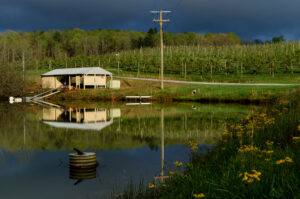 Petal fall is a critical time for management of plum curculio, and potentially oriental fruit moth and rosy apple aphid, the latter two dependent on what insecticides or mating disruption products were used before bloom. Also, if an insecticide targeting San Jose scale was not applied before bloom, petal fall to first cover falls in the timeframe for targeting this pest.
Petal fall is a critical time for management of plum curculio, and potentially oriental fruit moth and rosy apple aphid, the latter two dependent on what insecticides or mating disruption products were used before bloom. Also, if an insecticide targeting San Jose scale was not applied before bloom, petal fall to first cover falls in the timeframe for targeting this pest.
It is also important to note that most orchards consist of multiple apple cultivars that have differing times for petal fall, and precautions should be taken to avoid exposing bees to insecticide sprays or residues in flowers.
Petal Fall Sprays and Bee Safety
Minimizing risk of insecticide exposure to bees involves common sense and following restrictions on labels. The following guidelines should be used:
- Insecticides should not be applied before >90% of petals have fallen from blooms. Anytime before this stage risks exposing bees to insecticides. This is especially true when applying insecticides highly toxic to bees (see table below).
- Insecticides toxic to bees should not be applied before hives are removed from an orchard, regardless of the presence or absence of flowers.
- In orchards with multiple cultivars, avoid spraying insecticides until petal fall is complete on all cultivars. Attempting to spray trees that have completed petal fall but which are adjacent to those with blooms still present, will likely expose bees on blooming trees due to spray drift directly or indirectly (i.e., spray drift to flowers can contaminate nectar and pollen).
Insecticide Options for Petal Fall
Insecticide recommendations at petal fall are shown in the table below. Unfortunately, most are highly toxic to bees, especially those recommended for plum curculio – the key target at this time. Hence, the importance of waiting until >90% petal fall to make applications.
Plum curculio (PC): The key pest at this time, and the one which should be a strong basis for insecticide selection.
Oriental fruit moth (OFM): Another common pest, and the first generation can be easily managed with an insecticide applied at petal fall. However, in orchards using mating disruption and where dispensers were in place by before pink, insecticides are probably not necessary.
Rosy apple aphid (RAA): Rosy apple aphid control at petal fall is only necessary if an insecticide effective against this pest was not applied before bloom, at the tight cluster to pink stage.
San Jose scale (SJS): If an insecticide targeting San Jose scale was not applied before bloom, the window for making a post bloom spray extends from petal fall to first cover.
Preventive control of Mites: For those that prefer preventive control of European red mites, petal fall is the optimum timing if using Agri-Mek. The efficacy will noticeably decline the further from petal fall it is applied. If using insect growth regulators (e.g., Apollo, Savey, Zeal) or Envidor, it is recommended to wait until first or second cover.
Relative Efficacy of Insecticides for Petal Fall
(─ no activity, 1 = least effective, 5 = most effective)
| Insecticide (active ingredient) | PC | OFM | RAA | SJS | Toxicity to Bees |
| Actara (thiamethoxam) | 5 | 2 | 5 | ─ | Highly toxic |
| Assail (acetamiprid) | 3 | 4 | 5 | 4 | Moderately toxic |
| Belay (chlothianidin) | 4 | 3 | 5 | ─ | Highly toxic |
| Avaunt (Indoxacarb) | 4 | 4 | ─ | ─ | Highly toxic |
| Imidan (phosmet) | 4 | 4 | ─ | 1 | Highly toxic |
| Verdepryn (cyclaniliprole) | 4 | 5 | ─ | 3 | Highly toxic |
| Sevin (carbaryl) | 3 | 3 | ─ | 2 | Highly toxic |
| Voliam Flexi (thiamethoxam + chlorantraniliprole) | 5 | 5 | 5 | ─ | Highly toxic |
| Esteem (pyriproxyfen) | ─ | 4 | 2 | 5 | Slightly toxic |
| Centaur (buprofezin) | ─ | ─ | ─ | 5 | Slightly toxic |
| Movento (spirotetramat) | ─ | ─ | 5 | 4 | Moderately toxic |
Learn more about southeastern apple insect pests at the Apple Insect Management page.
2025 Average Weekly Trap Captures
| HENDERSON COUNTY | |||
| Insects per trap | |||
| Mar 31 | Apr 7 | Apr 14 | |
| Codling moth | 0.0 | 0.0 | 0.0 |
| Oriental fruit moth | 75.0 | 76.5 | 18.5 |
| Tufted apple bud moth | n/a | 0.0 | 1.0 |
| Redbanded leafroller | 21.0 | 6.0 | 4.0 |
| Obliquebanded leafroller | n/a | n/a | n/a |
| Lesser appleworm | n/a | n/a | n/a |
| Apple maggot (research orchards) | n/a | n/a | n/a |
| Apple maggot (abandoned orchard) | n/a | n/a | n/a |
| Brown marmorated stink bug (commercial) | n/a | n/a | n/a |
| Brown marmorated stink bug (unsprayed research orchard) | n/a | 0.5 | 0.0 |
| Spotted tentiform leafminer | 0.0 | 0.0 | 0.0 |
| Dogwood borer | n/a | n/a | n/a |
| Peachtree borer | n/a | n/a | n/a |
| Lesser peachtree borer | n/a | 2.0 | 3.0 |
| San Jose scale | 0.0 | 0.0 | 0.0 |
*Note that these averages illustrate only the timing of insect emergence and fluctuations in populations, and are not representative of population levels in any given orchard. The only way to have an accurate assessment of an individual orchard’s populations is to set up traps in that orchard.
2025 Accumulated Degree Days
| HENDERSON COUNTY | ||||
| Mar 31 | Apr 7 | Apr 14 | ||
| Codling moth (Biofix not yet reached) | n/a | n/a | n/a | |
| Oriental fruit moth (Biofix: March 17) | 125 | 263 | 304 | |
| Tufted apple bud moth (Biofix not yet reached) | n/a | n/a | n/a | |
April 7, 2025
Learn more about southeastern apple insect pests at the Apple Insect Management page.
2025 Average Weekly Trap Captures
| HENDERSON COUNTY | |||
| Insects per trap | |||
| Mar 24 | Mar 31 | Apr 7 | |
| Codling moth | 0.0 | 0.0 | 0.0 |
| Oriental fruit moth | 3.0 | 75.0 | 76.5 |
| Tufted apple bud moth | n/a | n/a | 0.0 |
| Redbanded leafroller | 20.0 | 21.0 | 6.0 |
| Obliquebanded leafroller | n/a | n/a | n/a |
| Lesser appleworm | n/a | n/a | n/a |
| Apple maggot (research orchards) | n/a | n/a | n/a |
| Apple maggot (abandoned orchard) | n/a | n/a | n/a |
| Brown marmorated stink bug (commercial) | n/a | n/a | n/a |
| Brown marmorated stink bug (unsprayed research orchard) | n/a | n/a | 0.5 |
| Spotted tentiform leafminer | 0.0 | 0.0 | 0.0 |
| Dogwood borer | n/a | n/a | n/a |
| Peachtree borer | n/a | n/a | n/a |
| Lesser peachtree borer | n/a | n/a | 2.0 |
| San Jose scale | 0.0 | 0.0 | 0.0 |
*Note that these averages illustrate only the timing of insect emergence and fluctuations in populations, and are not representative of population levels in any given orchard. The only way to have an accurate assessment of an individual orchard’s populations is to set up traps in that orchard.
2025 Accumulated Degree Days
| HENDERSON COUNTY | ||||
| Mar 24 | Mar 31 | Apr 7 | ||
| Codling moth (Biofix not yet reached) | n/a | n/a | n/a | |
| Oriental fruit moth (Biofix: March 17) | 58 | 125 | 263 | |
| Tufted apple bud moth (Biofix not yet reached) | n/a | n/a | n/a | |
March 31, 2025
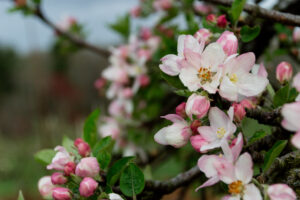 With trees either in or approaching bloom, hopefully orchards have received an oil application at green tip for early season suppression of San Jose scale (SJS) and European red mite (ERM). Additionally, an insecticide application between tight cluster to pink is an option for additional protection against SJS, and for preventive control of rosy apple aphid. If these latter applications were not made, post bloom options remain for control these two insects.
With trees either in or approaching bloom, hopefully orchards have received an oil application at green tip for early season suppression of San Jose scale (SJS) and European red mite (ERM). Additionally, an insecticide application between tight cluster to pink is an option for additional protection against SJS, and for preventive control of rosy apple aphid. If these latter applications were not made, post bloom options remain for control these two insects.
San Jose Scale: In addition to Esteem and Centaur, which are the two most effective materials and can be applied either before or after bloom, the organophosphates Diazinon and chlorpyrifos (2025 is the last year for use) are registered for use before bloom. However, these two older materials are generally not as effective. The neonicotinoid Assail also has good activity against SJS, especially when applied after bloom.
Rosy Apple Aphid: Historically, rosy apple aphid (RAA) control has been achieved with an effective material applied either before bloom at pink, or post bloom at petal fall. However, in recent years the petal fall timing, in the absence of a prebloom spray, has not been as effective. RAA overwinters in the egg stage, and eggs begin to hatch at petal fall when they are most vulnerable to insecticides. There are several options for the pink spray, including Assail, Sivanto Prime, Versys, and Beleaf, all of which will provide good control of RAA and are among the products less harmful to pollinators.
The next Pest Update will focus on management of insects at petal fall.
Learn more about southeastern apple insect pests at the Apple Insect Management page.
2025 Average Weekly Trap Captures
| HENDERSON COUNTY | |||
| Insects per trap | |||
| Mar 17 | Mar 24 | Mar 31 | |
| Codling moth | 0.0 | 0.0 | 0.0 |
| Oriental fruit moth | 1.0 | 3.0 | 75.0 |
| Tufted apple bud moth | n/a | n/a | n/a |
| Redbanded leafroller | 20.0 | 20.0 | 21.0 |
| Obliquebanded leafroller | n/a | n/a | n/a |
| Lesser appleworm | n/a | n/a | n/a |
| Apple maggot (research orchards) | n/a | n/a | n/a |
| Apple maggot (abandoned orchard) | n/a | n/a | n/a |
| Brown marmorated stink bug (commercial) | n/a | n/a | n/a |
| Brown marmorated stink bug (unsprayed research orchard) | n/a | n/a | n/a |
| Spotted tentiform leafminer | 0.0 | 0.0 | 0.0 |
| Dogwood borer | n/a | n/a | n/a |
| Peachtree borer | n/a | n/a | n/a |
| Lesser peachtree borer | n/a | n/a | n/a |
| San Jose scale | 0.0 | 0.0 | 0.0 |
*Note that these averages illustrate only the timing of insect emergence and fluctuations in populations, and are not representative of population levels in any given orchard. The only way to have an accurate assessment of an individual orchard’s populations is to set up traps in that orchard.
2025 Accumulated Degree Days
| HENDERSON COUNTY | ||||
| Mar 17 | Mar 24 | Mar 31 | ||
| Codling moth (Biofix not yet reached) | n/a | n/a | n/a | |
| Oriental fruit moth (Biofix: March 17) | Biofix | 58 | 125 | |
| Tufted apple bud moth (Biofix not yet reached) | n/a | n/a | n/a | |



